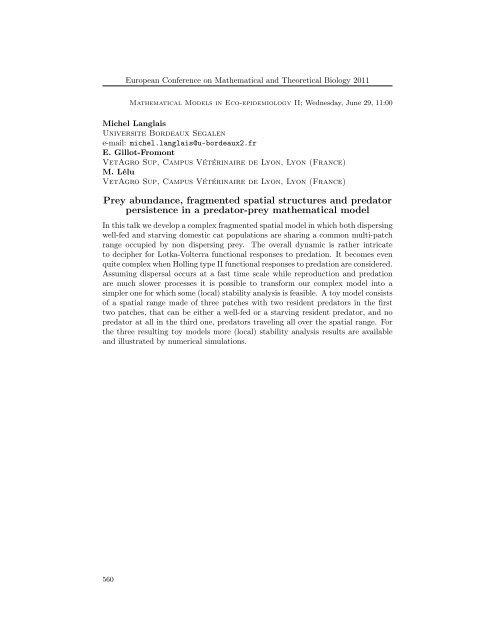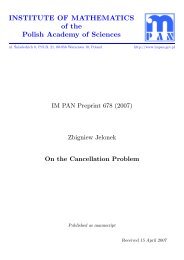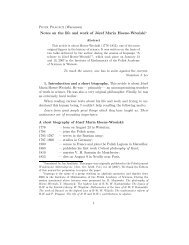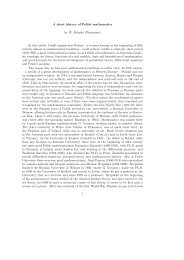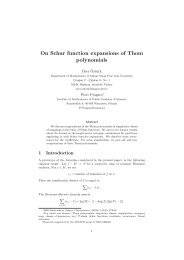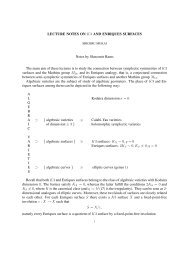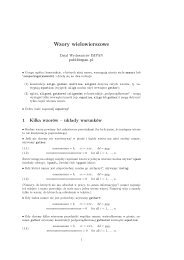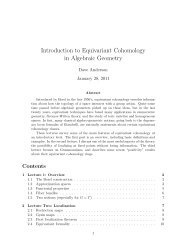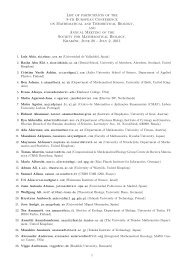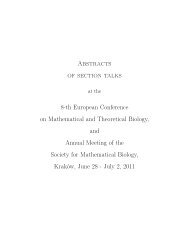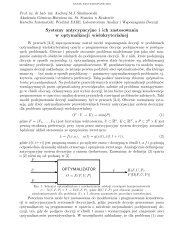Abstracts of Posters 8-th European Conference on Mathematical ...
Abstracts of Posters 8-th European Conference on Mathematical ...
Abstracts of Posters 8-th European Conference on Mathematical ...
You also want an ePaper? Increase the reach of your titles
YUMPU automatically turns print PDFs into web optimized ePapers that Google loves.
<str<strong>on</strong>g>European</str<strong>on</strong>g> <str<strong>on</strong>g>C<strong>on</strong>ference</str<strong>on</strong>g> <strong>on</strong> Ma<str<strong>on</strong>g>th</str<strong>on</strong>g>ematical and Theoretical Biology 2011<br />
Ma<str<strong>on</strong>g>th</str<strong>on</strong>g>ematical Models in Eco-epidemiology II; Wednesday, June 29, 11:00<br />
Michel Langlais<br />
Universite Bordeaux Segalen<br />
e-mail: michel.langlais@u-bordeaux2.fr<br />
E. Gillot-From<strong>on</strong>t<br />
VetAgro Sup, Campus Vétérinaire de Ly<strong>on</strong>, Ly<strong>on</strong> (France)<br />
M. Lélu<br />
VetAgro Sup, Campus Vétérinaire de Ly<strong>on</strong>, Ly<strong>on</strong> (France)<br />
Prey abundance, fragmented spatial structures and predator<br />
persistence in a predator-prey ma<str<strong>on</strong>g>th</str<strong>on</strong>g>ematical model<br />
In <str<strong>on</strong>g>th</str<strong>on</strong>g>is talk we develop a complex fragmented spatial model in which bo<str<strong>on</strong>g>th</str<strong>on</strong>g> dispersing<br />
well-fed and starving domestic cat populati<strong>on</strong>s are sharing a comm<strong>on</strong> multi-patch<br />
range occupied by n<strong>on</strong> dispersing prey. The overall dynamic is ra<str<strong>on</strong>g>th</str<strong>on</strong>g>er intricate<br />
to decipher for Lotka-Volterra functi<strong>on</strong>al resp<strong>on</strong>ses to predati<strong>on</strong>. It becomes even<br />
quite complex when Holling type II functi<strong>on</strong>al resp<strong>on</strong>ses to predati<strong>on</strong> are c<strong>on</strong>sidered.<br />
Assuming dispersal occurs at a fast time scale while reproducti<strong>on</strong> and predati<strong>on</strong><br />
are much slower processes it is possible to transform our complex model into a<br />
simpler <strong>on</strong>e for which some (local) stability analysis is feasible. A toy model c<strong>on</strong>sists<br />
<str<strong>on</strong>g>of</str<strong>on</strong>g> a spatial range made <str<strong>on</strong>g>of</str<strong>on</strong>g> <str<strong>on</strong>g>th</str<strong>on</strong>g>ree patches wi<str<strong>on</strong>g>th</str<strong>on</strong>g> two resident predators in <str<strong>on</strong>g>th</str<strong>on</strong>g>e first<br />
two patches, <str<strong>on</strong>g>th</str<strong>on</strong>g>at can be ei<str<strong>on</strong>g>th</str<strong>on</strong>g>er a well-fed or a starving resident predator, and no<br />
predator at all in <str<strong>on</strong>g>th</str<strong>on</strong>g>e <str<strong>on</strong>g>th</str<strong>on</strong>g>ird <strong>on</strong>e, predators traveling all over <str<strong>on</strong>g>th</str<strong>on</strong>g>e spatial range. For<br />
<str<strong>on</strong>g>th</str<strong>on</strong>g>e <str<strong>on</strong>g>th</str<strong>on</strong>g>ree resulting toy models more (local) stability analysis results are available<br />
and illustrated by numerical simulati<strong>on</strong>s.<br />
560


